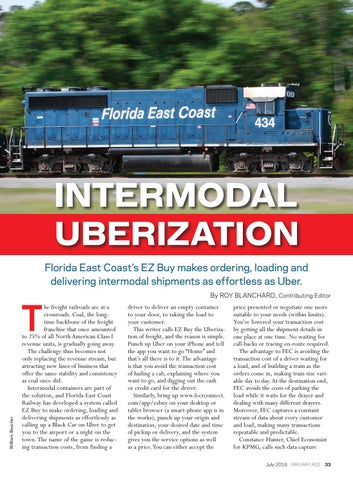Intermodal Uberization Florida East Coast’s EZ Buy makes ordering, loading and delivering intermodal shipments as effortless as Uber.
William Beecher
T
he freight railroads are at a crossroads. Coal, the longtime backbone of the freight franchise that once amounted to 25% of all North American Class I revenue units, is gradually going away. The challenge thus becomes not only replacing the revenue stream, but attracting new lines of business that offer the same stability and consistency as coal once did. Intermodal containers are part of the solution, and Florida East Coast Railway has developed a system called EZ Buy to make ordering, loading and delivering shipments as effortlessly as calling up a Black Car on Uber to get you to the airport or a night on the town. The name of the game is reducing transaction costs, from finding a
By ROY BLANCHARD, Contributing Editor
driver to deliver an empty container to your door, to taking the load to your customer. This writer calls EZ Buy the Uberization of freight, and the reason is simple. Punch up Uber on your iPhone and tell the app you want to go “Home” and that’s all there is to it. The advantage is that you avoid the transaction cost of hailing a cab, explaining where you want to go, and digging out the cash or credit card for the driver. Similarly, bring up www.fecrconnect. com/app/ezbuy on your desktop or tablet browser (a smart-phone app is in the works), punch up your origin and destination, your desired date and time of pickup or delivery, and the system gives you the service options as well as a price. You can either accept the
price presented or negotiate one more suitable to your needs (within limits). You’ve lowered your transaction cost by getting all the shipment details in one place at one time. No waiting for call-backs or tracing en-route required. The advantage to FEC is avoiding the transaction cost of a driver waiting for a load, and of building a train as the orders come in, making train size variable day to day. At the destination end, FEC avoids the costs of parking the load while it waits for the drayer and dealing with many different drayers. Moreover, FEC captures a constant stream of data about every customer and load, making many transactions repeatable and predictable. Constance Hunter, Chief Economist for KPMG, calls such data capture July 2016 Railway Age 33
